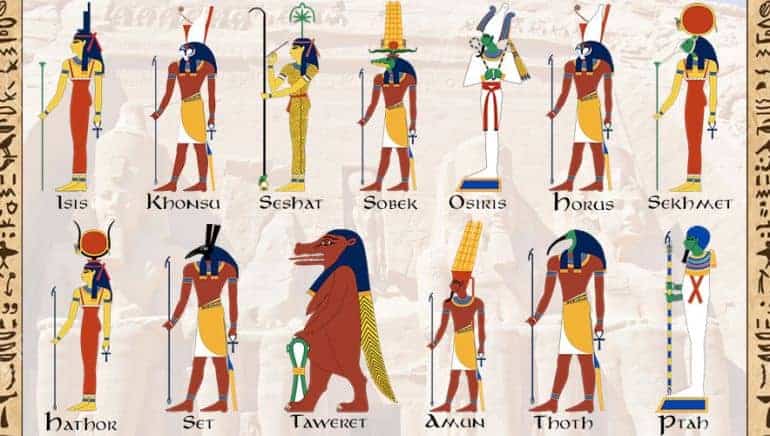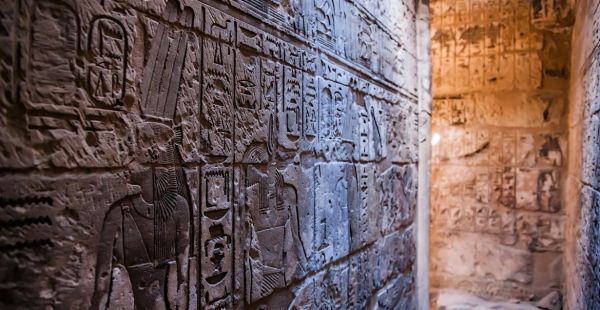List of ancient Egyptian deities
Ancient Egyptian mythology is known for its intricate and diverse pantheon of gods and goddesses. From powerful deities associated with the natural elements to gods and goddesses linked to the pharaohs and daily life, the mythology of Ancient Egypt is rich with fascinating tales and intricate beliefs. In this article, we will take a closer look at the gods and goddesses of Ancient Egypt, their significance, and how they influenced daily life and culture.
The Creation Myth
The creation myth of Ancient Egypt is a significant aspect of its mythology. It tells the story of the god Atum, who created the world by emerging from the chaotic waters of Nu. He then created the first gods, Shu and Tefnut, who were the gods of air and moisture, respectively. These two gods then gave birth to Geb, the god of the earth, and Nut, the goddess of the sky. Geb and Nut had four children, Osiris, Isis, Seth, and Nephthys, who went on to become some of the most significant gods and goddesses in the pantheon.
Top Gods and Goddesses of Ancient Egypt
Ancient Egypt had a rich and diverse pantheon of gods and goddesses, each with their own unique powers and domains. Here are some of the most prominent deities and how they were represented:
- Ra (or Re): The sun god, who was depicted as a falcon-headed man or as a man with a sun disk on his head. He was believed to be the king of the gods and the creator of the universe.
- Osiris: The god of the afterlife, who was usually depicted as a mummified man wearing a white cone-shaped headdress with ostrich feathers. He was responsible for judging the souls of the dead and was often associated with resurrection and fertility.
- Isis: The goddess of magic and motherhood, who was often represented as a woman with cow horns and a sun disk on her head, or as a woman with wings. She was the wife of Osiris and the mother of Horus, and was revered as a powerful protector of women and children.
- Horus: The god of the sky, who was often depicted as a falcon or as a man with a falcon head. He was also associated with kingship and was believed to be the son of Osiris and Isis.
- Anubis: The god of embalming and the dead, who was often depicted as a man with the head of a jackal. He was responsible for weighing the hearts of the deceased during the judgment of the dead.
- Bastet: The goddess of cats, fertility, and childbirth, who was usually depicted as a woman with the head of a cat. She was associated with domesticity and was revered as a protector of women and children.
- Thoth: The god of writing, knowledge, and wisdom, who was often depicted as a man with the head of an ibis. He was also associated with the moon and was believed to have invented writing and the calendar.
- Seth (or Set): The god of chaos and violence, who was usually depicted as a man with the head of an unknown animal (possibly aardvark or okapi). He was often portrayed as a rival to Horus and was responsible for the death of Osiris.
- Ma'at: The goddess of truth, justice, and order, who was often depicted as a woman with an ostrich feather on her head. She was associated with balance and harmony, and her presence was believed to ensure the smooth functioning of the universe.
- Hathor: The goddess of love, beauty, and music, who was usually depicted as a woman with cow ears and horns, or as a woman with a sun disk and cow horns. She was associated with fertility and motherhood, and was believed to have the power to bring happiness and joy.
- Ptah: The god of craftsmen and architects, who was often depicted as a man with a shaven head and a long beard. He was associated with creation and was believed to have created the world and all the other gods.
- Nefertum: The god of beauty and perfume, who was usually depicted as a man with a lotus flower on his head. He was associated with healing and was believed to have the power to cure diseases and promote physical and spiritual well-being.
- Sobek: The god of the Nile and crocodiles, who was often depicted as a man with the head of a crocodile. He was associated with fertility and was believed to have the power to protect the people from the dangers of the river.
- Sekhmet: The goddess of war and healing, who was usually depicted as a woman with the head of a lioness. She was associated with the destructive power of the sun and was believed to have the power to cure diseases and dispel evil.
- Tefnut: The goddess of moisture and rain, who was often depicted as a woman with the head of a lioness or as a woman with the sun disk and cow horns. She was associated with fertility and was believed to have the power to bring life-giving moisture to the land.
These are just a few examples of the rich and diverse pantheon of gods and goddesses in Ancient Egypt, each with their own unique attributes, powers, and representations.

Daily Life and Beliefs
The gods and goddesses of Ancient Egypt played an important role in the daily life of the people. They were believed to control various aspects of nature and daily life, and people would offer prayers and offerings to them in hopes of gaining their favor. The pharaohs were also believed to be divine and were considered to be the earthly manifestation of the god Horus. The mythology of Ancient Egypt also influenced the beliefs surrounding death and the afterlife. It was believed that the dead would have to pass through a series of tests and trials in order to reach the afterlife. The Book of the Dead was a collection of spells and incantations that were believed to aid the dead in this journey.
The gods and goddesses of Ancient Egypt represent a fascinating and intricate mythology that continues to captivate people to this day. Their influence can be seen in the art, architecture, and beliefs of the Ancient Egyptians, as well as in the many stories and legends that have been passed down through the centuries. From Ra, the powerful sun god, to Hathor, the goddess of beauty and music, each deity played a crucial role in the lives of the Ancient Egyptians and their beliefs about the world and the afterlife.
Today, the gods and goddesses of Ancient Egypt continue to fascinate and inspire people around the world, and their legacy can be seen in everything from popular culture to academic scholarship. Overall, their mythology remains a testament to the enduring power of human imagination and the enduring fascination with the divine.
Best Egypt Private Tours 2025
| Tour | Itinerary | Price |
|---|---|---|
| Luxor and Aswan Travels | 4 Days | $ 665 |
| Cairo Holiday Packages | 5 Days | $ 815 |
| Cairo to Petra Tour | 7 Days | $ 945 |
| Egypt and Dubai Tours | 8 Days | $ 999 |
| Turkey and Egypt Tours | 8 Days | $ 1060 |
| Wheelchair Accessible Nile Cruise | 4-5 Days | $ 1145 |
| Cairo and Luxor Holidays | 5 Days | $ 1225 |
| Egyptologist Tours | 7 Days | $ 1335 |
| Egypt Overland Tours | 8 Days | $ 1355 |
| Cairo and Nile Cruise Package | 7 Days | $ 1375 |
